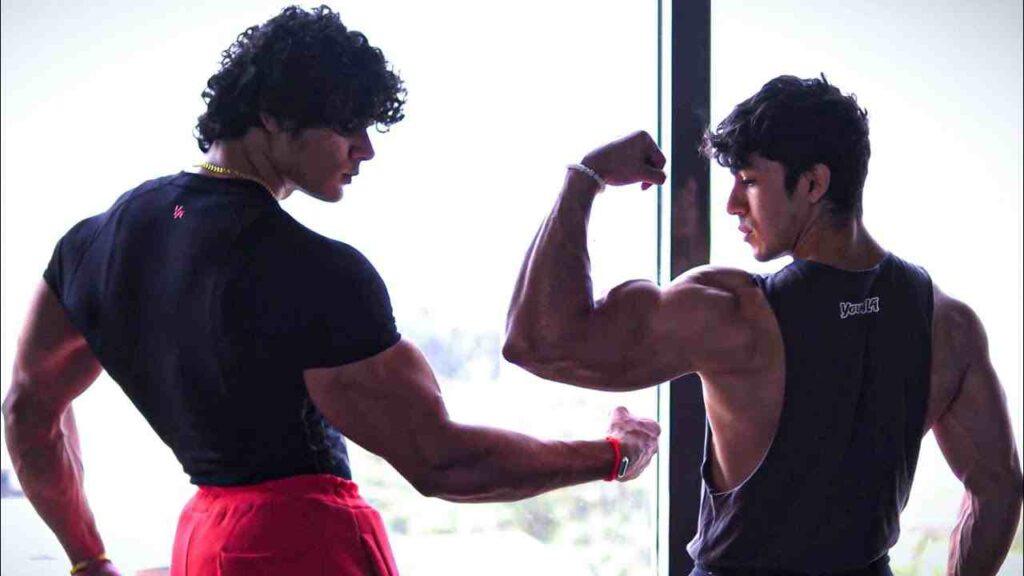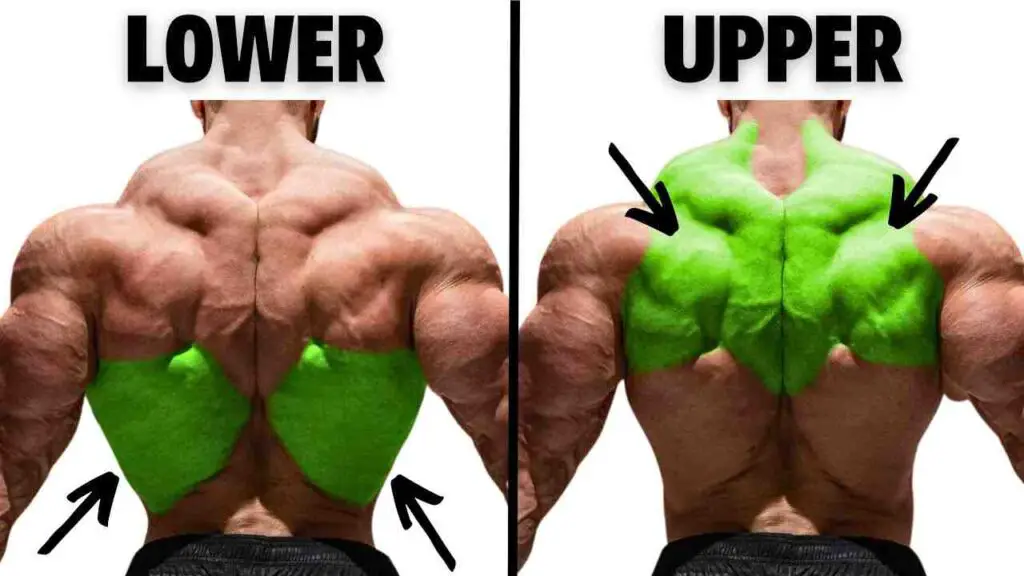Kettlebells, with their distinctive cannonball shape and off-center handle, have been a staple in strength training since the 18th century. But are they effective for building biceps, those muscles that are often considered a benchmark of physical fitness? The answer is a resounding yes. Kettlebells offer a unique way to target your biceps and can provide a variety of benefits that traditional weights might not.
SHOP FOR THE ADJUSTABLE DUMBBELL SET ON AMAZON
In this article, we’ll delve into the world of kettlebell training for biceps, exploring the benefits, the most effective exercises, and tips for incorporating kettlebells into your workout routine. So, whether you’re a fitness enthusiast looking to mix up your routine or a beginner seeking a versatile piece of equipment, read on to discover why kettlebells could be the key to stronger, more defined biceps.
Introduction to Kettlebells
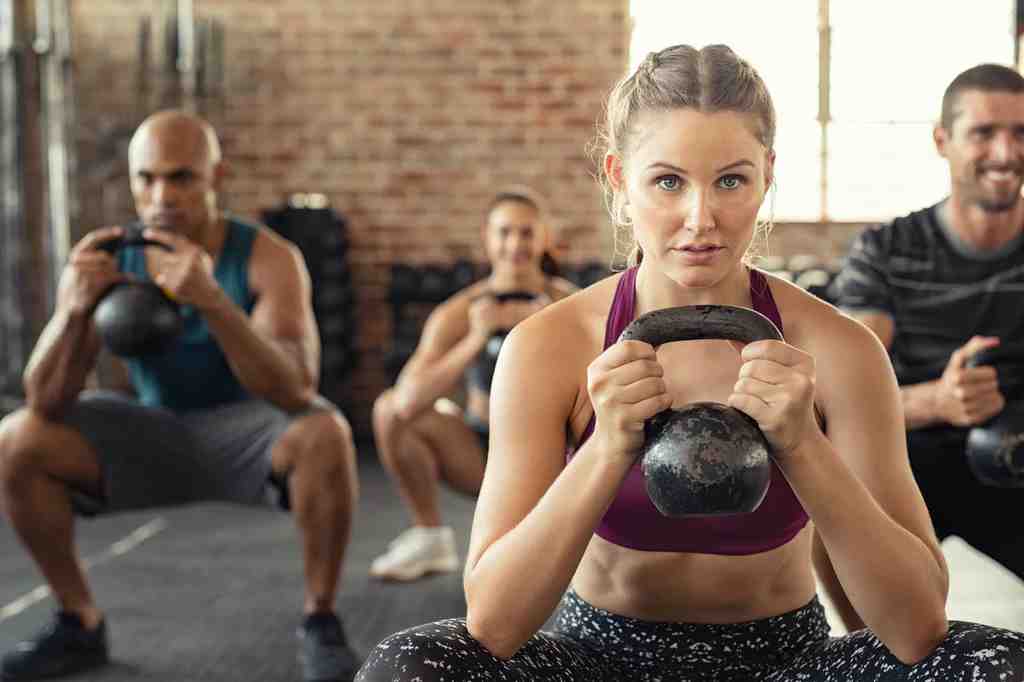
Kettlebells have surged in popularity in recent years, becoming a staple in many fitness enthusiasts’ routines. These cannonball-shaped weights with handles have been used for centuries, originating in Russia as a tool for weighing crops. However, they have evolved into a versatile piece of equipment for strength, conditioning, and functional training.
Unlike traditional dumbbells or barbells, kettlebells feature a unique design that places the weight below the handle, creating an off-center balance. This design requires greater stabilization and engages more muscles, making kettlebell exercises incredibly efficient for full-body workouts.
Kettlebell training offers a wide range of benefits, including improved strength, endurance, flexibility, and cardiovascular fitness. Whether you’re aiming to build muscle, burn fat, or enhance overall athleticism, kettlebells provide a dynamic and challenging workout experience.
Anatomy of the Biceps
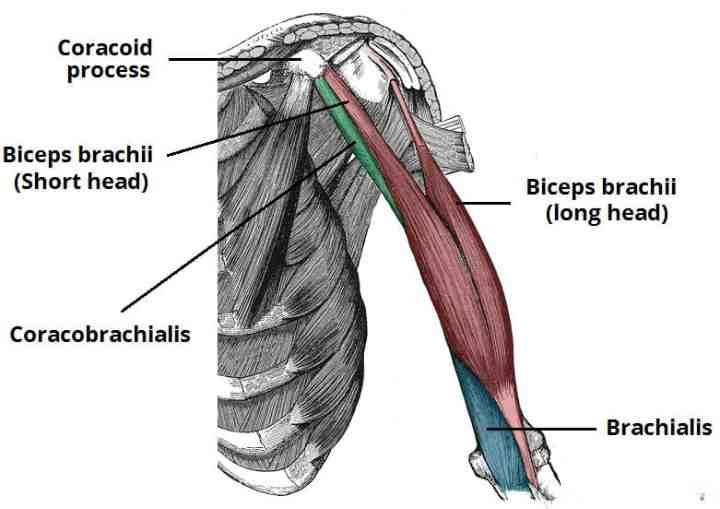
Understanding the anatomy of the biceps is crucial for anyone looking to effectively train and develop this muscle group. The biceps brachii, often simply referred to as the biceps, is a prominent muscle located in the upper arm. It consists of two heads: the long head and the short head.
- Long Head: The long head of the biceps originates from the supraglenoid tubercle of the scapula (shoulder blade) and runs along the humerus (upper arm bone), inserting into the radius bone in the forearm. This head of the biceps is primarily responsible for shoulder flexion and contributes significantly to the overall size and shape of the biceps muscle.
- Short Head: The short head of the biceps originates from the coracoid process of the scapula and also attaches to the humerus. It runs parallel to the long head but is situated on the inner side of the arm. The short head plays a role in elbow flexion and contributes to the overall strength and appearance of the biceps.
Both heads of the biceps merge together and form a single tendon, known as the biceps tendon, which attaches to the radius bone in the forearm. This tendon is important for stabilizing the elbow joint and allowing the biceps to exert force effectively during movements such as lifting and pulling.
SHOP FOR THE KETTLEBELL ON AMAZON
Functionally, the primary action of the biceps is elbow flexion, which involves bending the elbow joint to bring the forearm closer to the upper arm. Additionally, the biceps assists in various other movements, including supination (rotating the forearm so that the palm faces upward) and shoulder flexion (raising the arm forward and upward).
Benefits of Kettlebells for Biceps
Here are the benefits of using kettlebells for targeting the biceps:
- Engages Stabilizer Muscles: Kettlebell exercises for the biceps often involve movements that engage stabilizer muscles as well. This not only strengthens the biceps but also improves overall stability and coordination.
- Functional Strength: Kettlebell exercises mimic real-life movements more closely than traditional weightlifting exercises. This can translate to improved functional strength in activities of daily living that require bicep strength, such as lifting groceries or carrying bags.
- Versatility: Kettlebells offer a wide range of exercises that target the biceps from various angles. You can perform curls, hammer curls, and rotational movements to work the biceps and surrounding muscles effectively.
- Improved Grip Strength: Many kettlebell exercises require a strong grip to maintain control of the bell. This can lead to improvements in grip strength, which is essential for performing other compound exercises and activities.
- Cardiovascular Conditioning: Kettlebell exercises often involve dynamic movements that elevate the heart rate, providing cardiovascular benefits in addition to strength training. This can lead to improved overall fitness and calorie burning during workouts.
- Time Efficiency: Kettlebell exercises can be very time-efficient, as they often involve compound movements that work multiple muscle groups simultaneously. This means you can effectively target the biceps while also engaging other muscle groups in a single exercise.
- Minimal Equipment Required: With just one or two kettlebells, you can perform a full-body workout, including exercises targeting the biceps. This makes kettlebell training a convenient option for those with limited space or access to a gym.
- Joint-Friendly: Kettlebell exercises often involve fluid, natural movements that are easier on the joints compared to some traditional weightlifting exercises. This can be beneficial for individuals with joint issues or those looking to prevent injury.
SHOP FOR THE RESISTANCE BAND ON AMAZON
By incorporating kettlebell exercises into your workout routine, you can reap these benefits and effectively strengthen and sculpt your biceps.
Kettlebell Bicep Exercises
Here are several effective kettlebell exercises specifically targeting the biceps:
Kettlebell Bicep Curl

- This exercise targets the biceps by isolating the movement of curling the weight towards the shoulders.
- How to do: Stand with feet hip-width apart, holding a kettlebell in each hand with palms facing forward. Keeping your elbows close to your body, curl the kettlebells towards your shoulders, then lower them back down with control.
- Sets & Reps: Start with 3 sets of 8-12 reps.
- Tips: Focus on maintaining tension in the biceps throughout the movement. Avoid swinging the weights or using momentum to lift them.
Hammer Curl
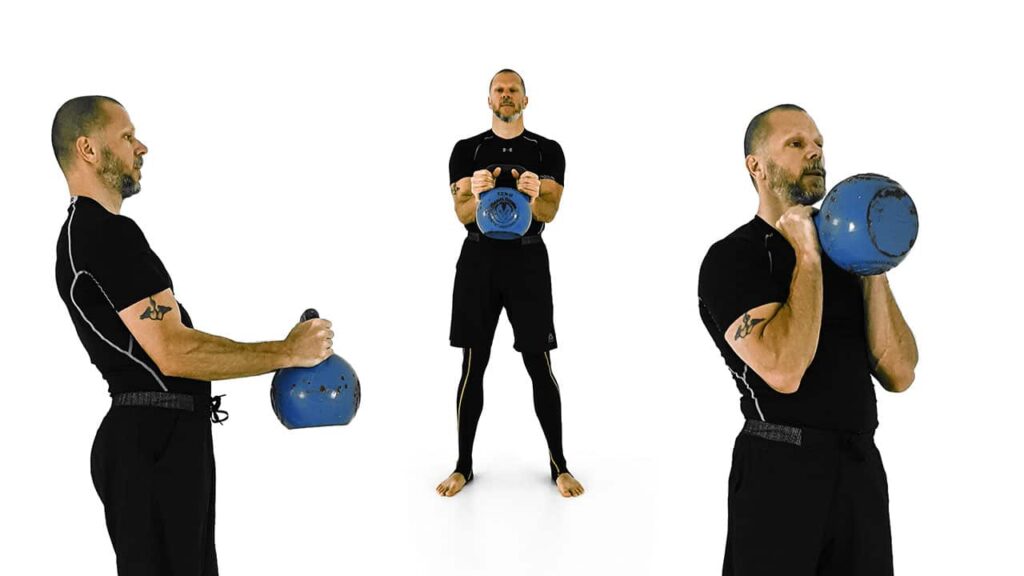
- The hammer curl targets both the biceps and the brachialis muscle, which lies underneath the biceps, resulting in overall arm development.
- How to do: Stand tall with a kettlebell in each hand, palms facing your thighs. Keeping your elbows close to your body, curl the kettlebells towards your shoulders in a hammering motion, then lower them back down.
- Sets & Reps: Aim for 3 sets of 10-15 reps.
- Tips: Keep your wrists neutral throughout the movement to maximize activation of the brachialis muscle. Control the weight and avoid swinging or jerking.
Kettlebell Zottman Curl
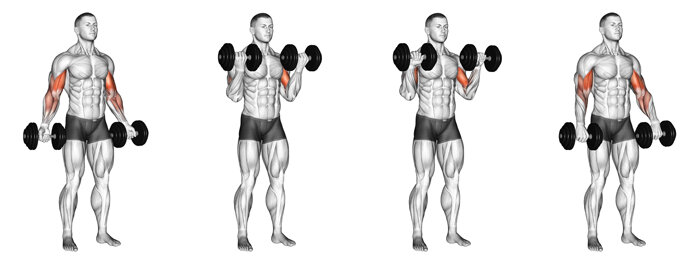
- This exercise targets the biceps during the concentric phase and the brachialis and brachioradialis muscles during the eccentric phase.
- How to do: Hold a kettlebell in each hand with palms facing up. Perform a traditional bicep curl, then rotate your wrists so that your palms are facing down (pronated grip) at the top of the movement. Slowly lower the kettlebells back down with palms facing down, then rotate back to the starting position.
- Sets & Reps: Perform 3 sets of 8-12 reps.
- Tips: Control the movement throughout the exercise, especially during the eccentric (lowering) phase. Focus on squeezing the biceps at the top of the movement.
Single-Arm Kettlebell Preacher Curl

- This variation of the curl isolates each arm, helping to correct muscle imbalances and enhance overall bicep development.
- How to do: Sit on a bench with a kettlebell beside you. Rest the back of your upper arm on the bench, ensuring your elbow is fully extended. Grasp the kettlebell with an underhand grip and curl it towards your shoulder, then lower it back down with control.
- Sets & Reps: Perform 3 sets of 8-12 reps per arm.
- Tips: Keep your upper arm firmly pressed against the bench throughout the movement to isolate the bicep. Maintain control and avoid swinging the weight.
Kettlebell Drag Curl
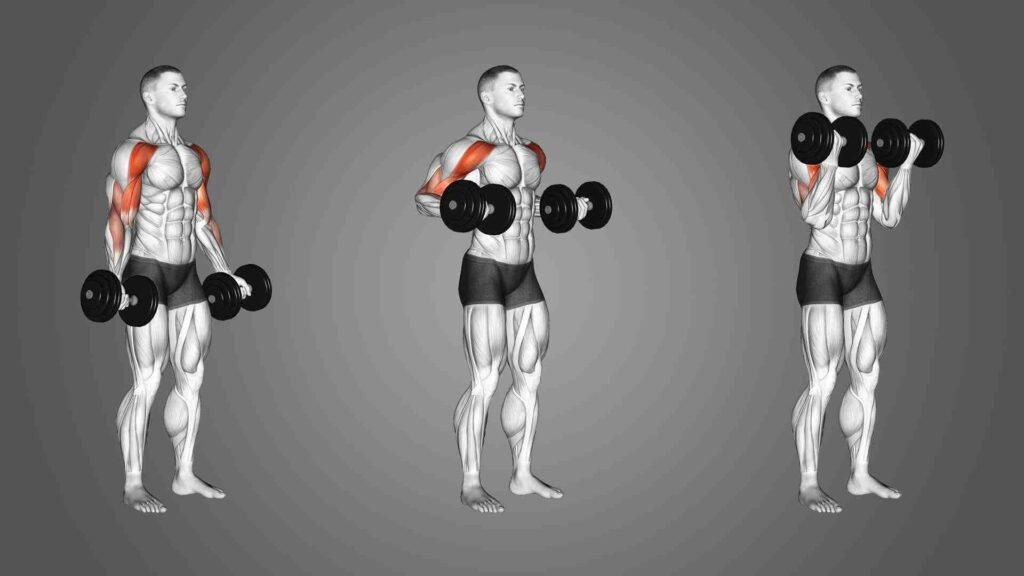
- This exercise emphasizes the peak contraction of the biceps, leading to increased muscle activation and growth.
- How to do: Stand with feet shoulder-width apart, holding a kettlebell in each hand with palms facing your thighs. Keeping your elbows close to your body, curl the kettlebells towards your shoulders while simultaneously dragging them along your torso, then lower them back down.
- Sets & Reps: Start with 3 sets of 10-12 reps.
- Tips: Focus on squeezing the biceps at the top of the movement and maintaining tension throughout the exercise. Keep your torso upright and avoid leaning back.
Kettlebell Concentration Curl
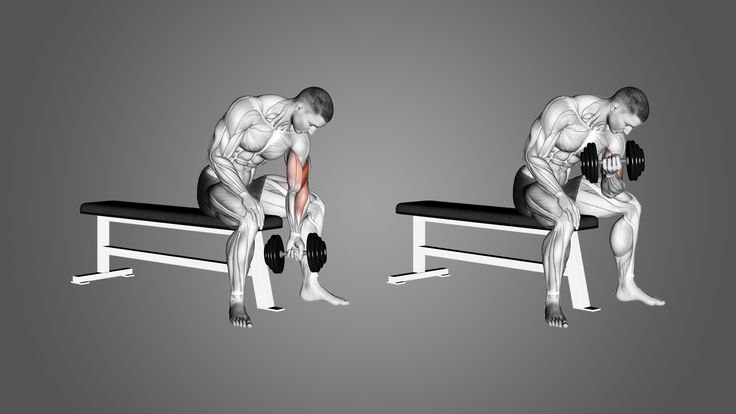
- This exercise isolates the biceps and helps improve their peak contraction for enhanced definition.
- How to do: Sit on a bench with your legs spread apart, holding a kettlebell in one hand between your legs with your arm fully extended. Curl the kettlebell towards your shoulder while keeping your upper arm stationary, then lower it back down with control.
- Sets & Reps: Aim for 3 sets of 10-15 reps per arm.
- Tips: Focus on maintaining strict form and avoiding momentum. Keep your elbow pressed against the inside of your thigh throughout the movement to maximize isolation.
Kettlebell Preacher Hammer Curl

- This exercise targets both the biceps and the brachialis muscle, helping to develop overall arm size and strength.
- How to do: Sit on a preacher bench with a kettlebell in each hand, palms facing your torso. Perform a hammer curl by curling the kettlebells towards your shoulders, then lower them back down with control.
- Sets & Reps: Perform 3 sets of 10-12 reps.
- Tips: Keep your upper arms firmly pressed against the preacher bench throughout the movement to isolate the biceps and maintain stability. Focus on controlling the weight and avoiding swinging.
SHOP FOR THE FITNESS TRACKER ON AMAZON
These exercises effectively target the biceps while also engaging other muscles such as the forearms and shoulders. Incorporate them into your workout routine with proper form and gradually increase the weight as you become stronger to continually challenge your muscles.
Impact on Workout Performance
Strong biceps, developed through kettlebell workouts, can have a significant impact on your overall workout performance. Here’s how:
- Improved Lifting Strength: Strong biceps can enhance your performance in exercises that require upper body strength, such as pull-ups and rows. They also play a crucial role in stabilizing lifts that engage the entire body, like the deadlift.
- Better Athletic Performance: Many sports and athletic activities, such as basketball, tennis, and rock climbing, require strong biceps for optimal performance.
- Injury Prevention: Strong biceps can help protect the joints from injuries, especially in the elbow and shoulder. They act as a support system for these joints during heavy or repetitive movements.
- Enhanced Physical Appearance: Well-developed biceps are often associated with a fit and healthy physique. They can contribute to a balanced and aesthetically pleasing muscular definition.
- Increased Endurance: Regular kettlebell workouts for your biceps can increase muscular endurance, allowing you to perform your workouts for longer periods without fatigue.
Remember, while biceps are important, it’s essential to maintain a balanced workout routine that targets all muscle groups for overall fitness and health.
Comparison with Other Equipment
When discussing the effectiveness of kettlebells for biceps training, it’s crucial to compare them with other types of equipment commonly used for this purpose. Here’s a breakdown of how kettlebells stack up against other equipment:
- Kettlebells vs Dumbbells: Dumbbells are great for targeted, isolated muscle workouts, especially for beginners. However, kettlebells, due to their design, offer a wider range of motion and engage more muscles at once. This can lead to improved functional strength and better muscle balance.
- Kettlebells vs Barbells: Barbells are typically used for heavy, compound lifts and are excellent for building overall strength. Kettlebells, on the other hand, are more versatile and can be used for a variety of exercises, including cardio, strength, and flexibility training.
- Kettlebells vs Resistance Bands: Resistance bands are lightweight, portable, and provide variable resistance, making them a good choice for rehabilitation and low-impact workouts. Kettlebells provide a fixed amount of resistance and are better suited for dynamic movements and building muscle mass.
- Kettlebells vs Machines: Workout machines typically target specific muscle groups and are safer for beginners due to their guided movements. Kettlebells require more control and stability, engaging more muscles and improving functional fitness.
Does Chest Supported Row Work Biceps?
Remember, each piece of equipment has its own benefits and is suited to different types of workouts. It’s always a good idea to incorporate a variety of equipment into your workout routine for a well-rounded fitness regimen.
FAQs
Q 1. What weight of kettlebell should I start with for bicep exercises?
Ans. It depends on your current fitness level. Beginners might start with lighter weights, such as 8-12 kg for men and 6-8 kg for women. As you build strength, you can gradually increase the weight.
Q 2. How often should I do kettlebell workouts for my biceps?
Ans. It’s generally recommended to train a muscle group 2-3 times per week. However, it’s important to listen to your body and allow adequate rest for muscle recovery.
Q 3. Are kettlebells suitable for beginners?
Ans. Yes, kettlebells are suitable for beginners. However, it’s important to learn the correct form and technique to avoid injury. It’s recommended to start with lighter weights and gradually increase as your strength improves.
Q 4. What are the common mistakes to avoid when doing kettlebell bicep exercises?
Ans. Some common mistakes include using too heavy a weight too soon, not maintaining a full range of motion, and not keeping the wrist straight during exercises. It’s important to maintain proper form and technique to avoid injury.
Q 5. Can I get a full-body workout using just kettlebells?
Ans. Absolutely! Kettlebells are incredibly versatile and can be used for a variety of exercises that target different muscle groups, providing a full-body workout.
Q 6. What are some signs of overdoing it with kettlebell workouts?
Ans. Signs of overdoing it might include excessive muscle soreness, decreased performance, increased resting heart rate, and persistent fatigue. It’s important to listen to your body and allow adequate rest and recovery.
Q 7. Are there specific warm-up exercises recommended before starting a kettlebell bicep workout?
Ans. A general warm-up that includes cardio and dynamic stretching is recommended. Specific warm-up exercises might include light kettlebell swings or arm circles to prepare the biceps for the workout.
Conclusion
In conclusion, kettlebells are indeed a powerful tool for bicep development. Their unique design allows for a full range of motion, increased tension on the muscles, and the engagement of multiple muscle groups, leading to improved functional strength and muscle balance.
While they may present a new challenge if you’re used to training with dumbbells or barbells, incorporating kettlebells into your workout routine can bring about significant benefits. Not only can they help build stronger, more defined biceps, but they can also enhance your overall workout performance and play a key role in injury prevention.

Good day, and welcome to Fitthour. My name is Shubham Vijay, and I am a certified personal trainer and nutrition coach with 6 years of experience in the fitness industry. At Fitthour, we specialize in types of training, such as strength training, cardio, or HIIT, and our mission is to help clients achieve their fitness goals and improve their overall health.

